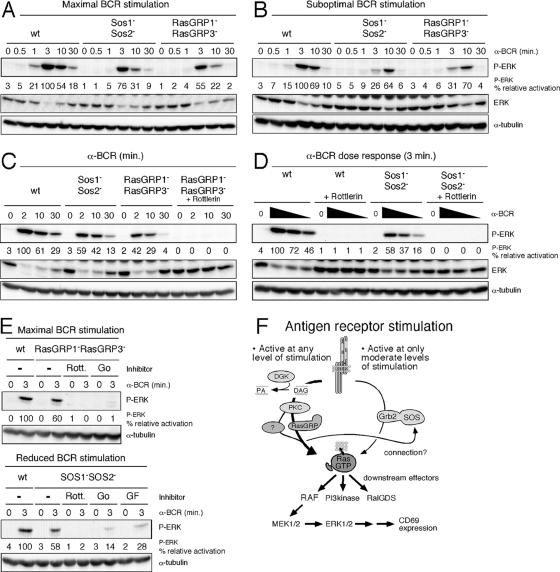FIG. 4.
Suboptimal BCR stimulation reveals SOS function. (A and B) Wild-type (wt) or DT40 chicken B-cell lines with the indicated targeted gene deletions were stimulated for the indicated intervals with BCR-stimulating M4 monoclonal antibody at either a maximal dose (A [1:1,000]) or a suboptimal dose (B [1:20,000]). NP-40 lysates were analyzed by Western blotting. The same portion of the blot was blotted for P-ERK and stripped, blotted for P-MEK1/2 and stripped, blotted for MEK1/2 and stripped, and blotted for ERK. Blotting for ERK after P-ERK typically gives inverted patterns compared to P-ERK. Note that DT40 B cells express only one ERK protein (chicken ERK2). A separate portion of the same blot was blotted for α-tubulin. The relative percentage of ERK phosphorylation was determined by normalizing for α-tubulin. α-BCR, anti-BCR. (C) The indicated DT40 lines were pretreated with DMSO (control) or rottlerin, stimulated with a 1:1,000 dilution of M4 monoclonal antibody as indicated, and analyzed as in panels A and B. (D) Wild-type or Sos1− Sos2− DT40 chicken B cells were pretreated with DMSO (control) or rottlerin and stimulated with control phosphate-buffered saline (0) or decreasing dilutions of BCR-stimulating M4 monoclonal antibody (1:1,000, 1:5,000, and 1:20,000) and analyzed as before. Of note, rottlerin did not lead to general cell toxicity as BCR (or TCR- or CD25ζζ-)-induced phosphorylation of MAP kinases other than ERK was less affected (data not shown). (E) The indicated DT40 lines were pretreated with DMSO (control), rottlerin, Go6976, or GF109203X and maximally stimulated with a 1:100 dilution of M4 monoclonal antibody (different M4 batch from those used in panels A to D) or with a reduced amount of 1:500 as indicated, and analyzed as before. (F) Model of Ras-RAF-MEK-ERK activation following antigen receptor engagement on lymphocytes. The pathway downstream of DAG dominates lymphocyte Ras activation. Our collective data suggest an unknown dependence of SOS function on the DAG-PKC-RasGRP pathway.

